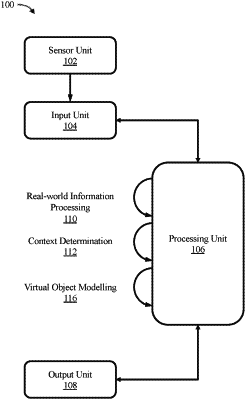| CPC G06T 15/506 (2013.01) [G06T 17/10 (2013.01); G06T 19/00 (2013.01)] | 14 Claims |

|
1. A system implemented in a computing device, for creating a context for a virtual object, said system comprising:
a processing unit comprising a processor coupled with a memory;
an input unit comprising:
one or more sensors coupled with the computing device, wherein the one or more sensors capture one or more parameters of one or more real-world elements of an augmented reality environment;
one or more pre-processors operatively coupled with the processing unit, wherein the one or more pre-processors perform pre-processing of raw sensed input data captured by the one or more sensors, wherein the processing unit is configured to:
receive values of the one or more parameters from the input unit;
create a three-dimensional textual matrix of sensor representation of a real environment world based on the one or more parameters, in real-time, wherein the processing unit create textual information that is reusable in the three-dimensional matrix; and
create a context of a specific virtual object from one or more virtual objects with respect to the real-world environment based on the three-dimensional textual matrix, wherein the context of the specific virtual object is created based on the context of one or more other virtual objects, and wherein each virtual object is divided into a plurality of parts and subparts, and wherein to create a context of a specific virtual object, the processing unit is further configured to:
determine factors including textures and one or more surfaces;
analyze each data point in the real-world environment based on the determined factors; and
place the virtual object in context based on the determined factors and analysed data points.
|